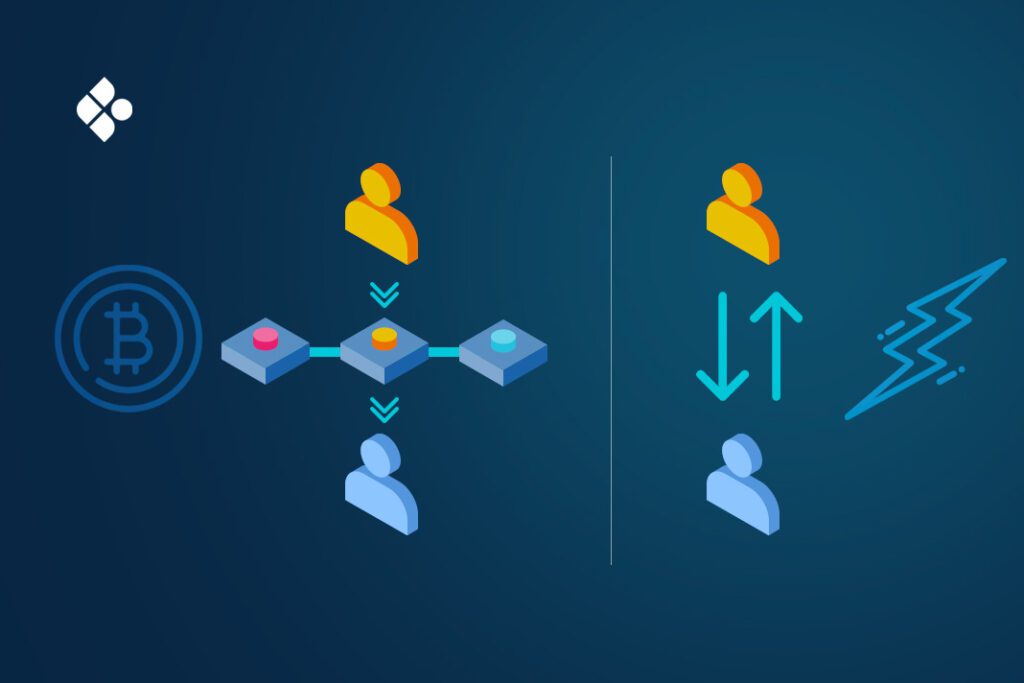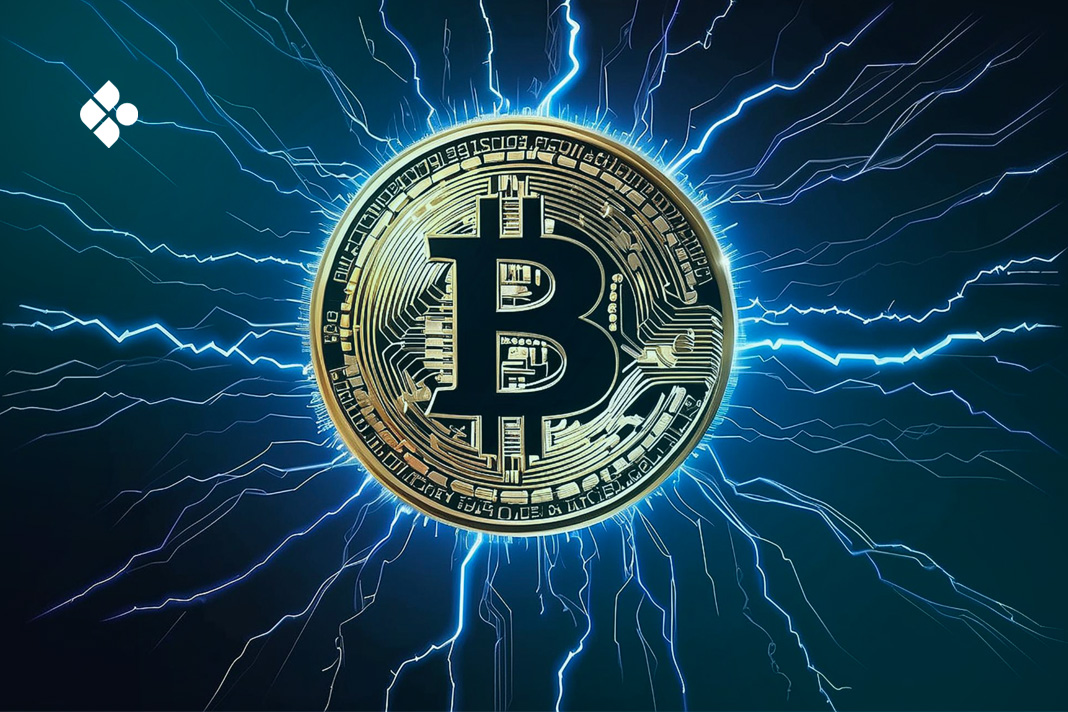Satoshi Nakamoto built the Bitcoin Network to be a decentralized peer-to-peer digital currency exchange system. While it seemed perfect at first, widespread adoption brought scalability Issues. Transaction costs rose, and transactions became slower.
Then in 2016, Thaddeus Dryja and Joseph Poon came up with a way to make these Bitcoin transactions faster and less expensive by taking it off-chain.
They called this solution the Bitcoin Lightning Network.
What is the Bitcoin Lightning Network?
The Bitcoin Lightning Network is a cryptocurrency network built on Bitcoin’s second layer.
It is a layer-2 protocol that was built as a result of the inefficiencies that surfaced as Bitcoin’s popularity grew and scalability became a problem.
The Lightning Network can be thought of as an off-chain technology designed to facilitate Bitcoin payments between two parties through a channel.
How does the Lightning Network work?

How the Bitcoin Lightning System works
On the Lightning Network, a secure channel is first created between the two transacting parties. Once the channel has been established, cryptocurrency can be sent to and fro in an instant with very low gas fees.
To create a channel, the initiator locks a certain amount of Bitcoin into the Lightning Network. Over time, the initiator can invoice small amounts from the locked Bitcoin.
The Lightning Network has a ledger separate from Bitcoin to facilitate instant transactions. This way, users can make micropayments quickly without the wait time that usually comes with using the main Bitcoin Network.
The transaction is then shifted to the main Bitcoin network only when the channel is closed.
Scalability Issues of the Bitcoin Network: Why was the Lightning Network made?
When Bitcoin was first introduced, it was meant to be a fully decentralized peer-to-peer payment system devoid of intermediaries. The ability to scale wasn’t given much attention.
As Bitcoin became more mainstream and more people used cryptocurrency, the Bitcoin Network became overloaded, causing issues that the Lightning Network seeks to solve.
The following are some of these issues:
1. Slower Transactions:
The Bitcoin Network can process a maximum of seven transactions per second. As more people started using the Bitcoin Network, this eventually led to slow confirmation times.
The Lightning Network solves this by introducing the off-chain model which can potentially let millions of transactions be carried out per second.
2. Excessive Energy Use:
With more users came the need to increase the rate of Bitcoin mining. The mining process consumes a lot of energy and as Bitcoin grew in popularity and adoption, the energy consumption also grew exponentially.
3. High Gas fees:
Gas fees are usually a function of how difficult it is to add a new block to the Blockchain.
When there are too many transactions to process per second, the block-adding problem is more difficult, leading to large gas fees.
The Lightning Network helps decongest the Bitcoin Network with gas fees averaging $0.85 per transaction.
Benefits of the Bitcoin Lightning Network
The following are some of the benefits of the Lightning Network:
1. Low Transaction Fees:
The transaction fees on the Lightning Network are considerably lower than on the Bitcoin Network.
Usually around $0.85. Unlike the Bitcoin Network in which transactions may cost up to $5 in gas fees.
This makes it ideal for micro and everyday payments.
2. Faster Transactions:
Transactions on the Bitcoin network usually take between 2-7 minutes as a result of massive use.
On the contrary, the Lightning Network enables almost instant Bitcoin transactions as time is saved by not waiting for confirmation from the nodes in the main Bitcoin Network.
3. Improved Privacy:
On layer one networks like the Bitcoin Network, details about all transactions are entered directly into the Blockchain for all to see, while on the Lightning Network, transactions are off-chain and entered on a separate ledger that is not public.
4. Reduced Energy Consumption:
The Lightning Network utilizes an off-chain transaction model and separate ledger thus, there is no need for energy consumption until the payment channel is closed.
This helps immensely in reducing energy use in mining and creating blocks.
Limitations of the Bitcoin Lightning Network
Even though the Lightning Network provides numerous advantages, it also has a number of limitations, which are:
1. Fraudulent Channel Close:
Since transactions are off-chain, it is possible that one of the two transacting parties closes the payment channel to steal the funds.
There is usually a short period to contest a sudden channel close, but if the victim party is away for long, the contesting window will elapse.
2. Lightning Network Fees:
One of the Lightning Network’s main selling points is that it reduces gas fees on the main Bitcoin Network by decongesting it.
That doesn’t seem to have worked, as gas fees on the Bitcoin Network have continued to increase due to the exponential increase in cryptocurrency adoption.
3. Introduction of Attack Vectors:
The introduction of the payment channels and how they operate in the Lightning Network can cause a malicious attack that leads to loss of funds.
If numerous payment channels are congested and an attacker finds a way to close many of those channels, the attacker could steal users’ funds as the congestion is shifted to the main Bitcoin network.
This was pointed out by Thaddeus Dryja, one of Lightning Networks’ founding researchers.
Frequently Asked Questions (FAQs) About the Bitcoin Lightning Network
Why are Lightning Network transactions faster than Bitcoin’s?
This is because transactions in the Lightning Network are done off-chain.
Off-chain transactions cut out the time used to wait for nodes to validate transactions and add them to the Blockchain.
Can the Lightning Network be hacked?
Like any other digital payment model or online infrastructure, the Lightning Network may have security vulnerabilities which, when spotted by someone skilled and malicious enough would lead to a hack attempt.
In fact, a critical vulnerability was discovered in the Lightning Network in 2022 and patched before it caused a loss of funds.
Can I earn money running a Lightning Node?
Yes. Individuals or corporations who run Lightning Nodes earn routing fees.
The fees are usually set small enough to keep transactions cheap but big enough to still be profitable for node runners.
Is Lightning Network still decentralized since it’s off-chain?
Yes. The Lightning Network is decentralized because it still depends on a network of nodes, and no single node has full control over the network.
Does the Lightning Network have its own cryptocurrency?
No. The Lightning Network is a layer-2 network built on top of the Bitcoin Network. It uses Bitcoin in its transactions.
Conclusion
The Lightning Network aims to solve the issues caused by network congestion in the Bitcoin Network. By using an off-chain model, nodes spend less time validating transactions, leading to faster, cheaper Bitcoin transactions.
However, the Lightning Network also came with problems with security and introduced new attack vectors. The Lightning Network is being improved on continuously to ensure safer, faster and cheaper Bitcoin transactions.
